Evolution of Surface Hydrology in the Sahelo-Sudanian Strip: An Updated Review
Abstract
1. Introduction
2. Material and Methods
2.1. Data
2.1.1. Hydrological Data
2.1.2. Rainfall Data and Processing Analysis
- -
- Most of the rainfall data are provided by National Meteorological Offices (Table 1).
- -
- However, for three areas, we used the Climate Hazards Group InfraRed Precipitation with Station (CHIRPS) data set [24]. This data set, which contains information from 1981 until just before the present, is an initiative of the U.S. Geological Survey (USGS) and the Climate Hazard Group (CHG), and is supported by several U.S. state institutions. It incorporates 0.05° resolution satellite imagery with in situ station data to create gridded rainfall time series for trend analysis. This data set was already used in several works, including in Africa [29,30,31].
- -
- The long-term rainfall evolution index in Section 6.2 is simply built with the % of annual variation vs. the mean value.
- -
- Trends and breaks in the annual rainfall and runoff coefficient series were determined through the following processes: determination of breaks and trends by the rank method and the Lee and Heghinian, Pettitt, Buishand principles, and finally the Hubert segmentation; all are processed using the Khronostat® 1.01 software of IRD [32].
- -
- Analysis of daily rainfall is conducted in two areas: Senegambia and the Middle Niger River Basin (MNRB). In each one of the areas, a dozen raingauges are considered for the 1951–2015 period. They are homogeneously distributed in space; regionalization was processed using Thiessen polygons. Only the Menaka station (destroyed in 2013) presents data gaps.
2.1.3. Land Use/Land Cover Changes (LULCC)
2.2. Methods of Hydrological Processes Upscaling and Synthesis
2.2.1. Trend of Runoff Coefficient
2.2.2. Comparison of Hydrographs
2.2.3. Principal Component Analysis (PCA)
3. “Sahelian Paradoxes” and Flooding Occurrence: Recent Advances in the Understanding of Sahelian and Sudanian Hydro Climatology
3.1. A Marked Increase in Runoff Coefficients and Discharges of Sahelian Rivers
3.2. A Reduced Lag Time, an Earlier Occurrence of Annual Flood
3.3. A More Intuitive Sudanian Functioning
3.3.1. The Sudanian Functioning at the Basin Scale
3.3.2. A Hewlettian Functioning at the Point and the Plot Scales
3.3.3. Lake Chad as an Indicator of Drought
3.3.4. Some Sudanian Rivers
3.3.5. Guinean Rivers Have the Same Behavior
3.3.6. As a Conclusion, the Temporal Evolution of the Sudanian Hydrological Style
3.4. Impacts of Dams and Irrigation
4. Upscaling of Hydrological Behaviors
4.1. Evolution of Runoff Coefficient during the 1968–1990s Drought
- -
- All the documented basins completely located in the Sahelian strip registered an increase in runoff coefficient during the dry 1968–1990s period. This finding is based on the studies dedicated respectively to the hydrological functioning of Sahelian [2,9,19,26,41,44,45,47,67,68] and Sudano-Guinean [25,27,28,57,59,60,61,62,63,69] basins, as well as comparisons between both series [3,18,20,51,64,66].
- -
- However, documented basins are far from covering the entire Sahelian strip. First, these basins are mostly located on exorheic areas, since endorheic ones, except the Lake Chad basin [57,58] are generally composed of small catchments [16,41,48,49,50,70] and are, therefore, not well documented. Otherwise, a great number of extended exorheic basins are either not or are no more extensively documented.
- -
- Large basins (Senegal River at Bakel, Niger River at Niamey and Chari River at N’Djamena) are much more influenced by the decrease in runoff of their upper basins than by the probable increase in runoff of their Sahelian part. The upper basins generate 90 to 97% of their total discharge.
- -
- -
- Finally, Figure 3 clearly highlights the contrast between:
- -
- The pure Sahelian basins, where RC (and, for most of them, discharges) increased during the drought (1st hydrological Sahelian paradox); some of the right bank tributaries of the Niger River at Sahelian latitude and the Nakanbé are those where runoff coefficient increased more significantly; and
- -
- Other basins, where, more intuitively, RC decreased. As shown by Amogu et al. [67], the decrease was more marked in Sudanian basins than in Guinean ones. As observed by Olivry [20] and Mahé et al. [19], in Sudanian regions, a decrease of 20–25% in rainfall provoked a drop of 55 to 70% in discharges.
4.2. Comparison of Annual Runoff Coefficient Evolution from 1950 to 2015
- -
- The first one is composed of great basins, where Sudanian behavior predominates: they showed a strong decrease in runoff coefficient (RC) during the 1968–1995 drought (Figure 4a).
- -
- The second type is the pure Sahelian type, characterized by an increase in RC during the drought, and an exacerbated increase observed with the rainfall recovery after the mid-1990s (Figure 4b).
- -
- The third one is the “Sudano-Guinean type”, where a partial RC recovery is observed after the rainfall recovery (Figure 4c), with two sub types 3-2 and 3-3 both characterized by a high part of missing data; type 3-2 gathers the basins with total recovery of RC, probably linked to the “sahelization” of the basin and the increase in runoff on degraded or crusted topsoils (Figure 4d); type 3-3 is characterized by a very partial recovery of RC after the drought; it is composed of southern tributaries of the Niger River (Figure 4e).
- -
- The fourth type is the pure Sudanian one, with no or very little recovery of the basins RC; this can be due to the high soil and landscape WHC, which imposes a very long refilling time of all the natural reservoirs (Figure 4f).
- -
- The fifth and last type is the pure Guinean type, characterized by high RC in the smaller basins in recent decades; a partial recovery of RC is observed. This area is characterized by a long time (several years) elapsed before being impacted by the drought, due to the high volume of natural reservoirs taking years to be emptied. The subtype 5-1 is that of granitic areas with little reservoirs, strong slopes, and thin soils: the RC dropped 4–5 years after rainfall in 1975–1977 (Figure 4g); type 5-2 is that of the upper Niger basin, where low slopes and metamorphic and alluvial outcrops allow higher volumes of stored water; they lasted 7 to 9 years before showing a marked decrease in RC after the beginning of dry period, around 1979–1980 (Figure 4h).
4.3. A Principal Component Analysis (PCA) of Basin Hydrological Behavior
5. Land Use/Land Cover Changes and Their Hydrological Consequences
5.1. Some Concepts in Land Use/Land Cover Change Studies
5.2. Evaluation of Global Vegetation Evolution through Remote Sensing Studies
5.3. Highlighting the Correlation between Land Use/Land Cover and Runoff Yield
5.4. A Common Explanation: The Reduction of both Hydraulic Conductivity and Roughness
5.5. Some Exacerbating Processes
5.5.1. Urbanization
- On the runoff, by decreasing infiltration: urbanization is known to lead to soil compaction and sharp reduction in water infiltration. It is both a cause of flooding due to high runoff coefficients and a cause of aggravated consequences of flooding, due to inundation and the damage to the built environment. Additionally, gutters are commonly clogged when no maintenance is routinely implemented, as it was observed in Bamako in August 2013;
- On cities and peoples’ vulnerability: flooding caused severe damage in unplanned urbanized areas, which have developed rapidly in sub-Saharan cities in recent decades, and are widespread in flooding zones due to both the strong migration pressure and limited control over this urbanization.
5.5.2. Silting Up
5.5.3. Endorheism Rupture
6. An Intensification of Rainfall
- -
- Determining the interannual evolution of rainfall amount and rainfall indexes, including the evolution of both the number of rainy days and the daily rainfall amount (Section 6.2);
- -
- Analyzing the interdecadal evolution of number of extreme events (here, daily rainfall amounts exceeding 60, 80 and 100 mm) (Section 6.3);
- -
- Studying the annual evolution of monsoon onset and the effectiveness of the monsoon according to agronomical criteria (Section 6.4).
6.1. Main Trends Described in Recent Works
- Locally, a rise in inter-annual variability compared with that observed before the dry period;
- All over the Sudano-Sahelian strip, since the minimum of the 1980s, an increase in extreme rainfall events, more pronounced that the increase in annual rainfall.
- Rainfall decadal variability induces land cover changes, such as ligneous vegetation dying, due to severe drought; this vegetation cover reduction could, in time, explain the increasing runoff and discharges;
- Some studies ([2,78,87,95,104] among others) have demonstrated that the re-greening does not prevent the increase in runoff and in basin discharge, due to the severe degradation of small parts of these basins, generally located near the “kori”. The intensification of rainfall began in the middle of the 1980s, but it reached its maximum in the middle of the 2001–2010 decade [4,7]. At that date, at least 90% of the increase in stream flows had already been realized. The rainfall evolution in West Africa contributes to the increasing trend of runoff and rivers discharges. Below, several indicators are used to assess this contribution. More precisely, we analyze the annual rainfall amount, rainfall index, rainfall intensity and monsoon seasonal pattern. In this section, we will analyze the spatio-temporal evolution of daily rainfall for two areas: Senegambia and the MNRB (see location in Figure 9), and for the 1951–2015 period.
6.2. Annual Rainfall Amount and Indexes
6.3. Extreme Events: An Intensification of Rainfall?
- The current intensification contributes to the increase in runoff (accompanied by other factors);
- The intra-seasonal distribution of extreme events has likely changed, and should be analyzed further in future studies;
- An increase in maximal instant rainfall intensity and maximal rainfall at 5 min time step has been noticed in the very last few years [116].
6.4. The Onset of the Monsoon, through Agronomical Criteria
7. Conclusions and Perspectives
- Urbanization throughout the whole Sudano-Sahelian strip, which exacerbates runoff coefficients;
- The net increase in extreme rainfall events, with severe consequences in rural and, more recently, in urban areas too.
- The period of the 1st Sahelian Paradox (declining rainfall, increasing runoff and discharges), which is commonly attributed to LULCC, the decline of vegetation cover being due both to the severe rainfall deficit and associated woody vegetation dying, and to the increase in vegetation exploitation by a growing population (West Africa has had the highest demographic growth rate in the world since the 1980s);
- The period following the “Great Drought”, which was characterized by a general vegetation re-greening (observed by remote sensing) and vegetal net primary productivity increase, as a rise in discharges of Sahelian rivers was occurring. The 2nd Sahelian paradox (increase in runoff and increase in vegetation cover) is explained by both rainfall intensification and a reduction in soil WHC, probably linked to extension in cropping areas, as well as vegetation degradation and soil erosion over shallow soils [20,26,38,39,53,76,77,80].
- To increase the number of field and satellite observations of the basins, at different spatial scales, in order to document LULCC, associate processes and relevant variables;
- To monitor the soil crusting processes and its spatial extension;
- To better understand, analyze and model urban hydrology, as urbanization progression in West Africa is also the highest in the world, mostly due to the low current urbanization rate;
- To improve the knowledge of the role of imperviousness and of drainage system;
- To implement adapted hydrological modelling accounting for these processes and adopting rigorous statistical attribution approaches, as suggested, e.g., by Merz et al. (2012) [119].
Author Contributions
Acknowledgments
Conflicts of Interest
References
- Nicholson, S.E.; Tucker, C.J.; Ba, B. Desertification, drought and surface vegetation: An example from the West African Sahel. Bull. Am. Meteorol. Soc. 1998, 79, 815–829. [Google Scholar] [CrossRef]
- Descroix, L.; Genthon, P.; Amogu, O.; Rajot, J.-L.; Sighomnou, D.; Vauclin, M. Change in Sahelian Rivers hydrograph: The case of recent red floods of the Niger River in the Niamey region. Glob. Planet. Chang. 2012, 98–99, 18–30. [Google Scholar] [CrossRef]
- Nka, B.N.; Oudin, L.; Karambiri, H.; Paturel, J.-E.; Ribstein, P. Trends in floods in West Africa: Analysis based on 11 catchments in the region. Hydrol. Earth Syst. Sci. 2015, 19, 4707–4719. [Google Scholar] [CrossRef]
- Panthou, G.; Vischel, T.; Lebel, T. Recent trends in the regime of extreme rainfall in the Central Sahel. Int. J. Climatol. 2014, 34, 3998–4006. [Google Scholar] [CrossRef]
- Taylor, C.M.; Belušić, D.; Guichard, F.; Parker, D.J.; Vischel, T.; Bock, O.; Harris, P.P.; Janicot, S.; Klien, C.; Panthou, G. Frequency of extreme Sahelian storms tripled since 1982 in satellite observations. Nature 2017, 544, 475–480. [Google Scholar] [CrossRef] [PubMed]
- Descroix, L.; Bouzou Moussa, I.; Genthon, P.; Sighomnou, D.; Mahé, G.; Mamadou, I.; Vandervaere, J.-P.; Gautier, E.; Faran Maiga, O.; Rajot, J.-L.; et al. Impact of Drought and Land—Use Changes on Surface. Water Quality and Quantity: Chapter 10: The Sahelian Paradox; InTech: Zagreb, Croatie, 2013; pp. 243–271. [Google Scholar] [CrossRef]
- Descroix, L.; Diongue Niang, A.; Panthou, G.; Bodian, A.; Sané, T.; Dacosta, H.; Malam Abdou, M.; Vandervaere, J.-P.; Quantin, G. Evolution récente de la mousson en Afrique de l’Ouest à travers deux fenêtres (Sénégambie et Bassin du Niger Moyen). Climatologie 2015, 12, 25–43. Available online: http://lodel.irevues.inist.fr/climatologie/ (accessed on 12 February 2018).
- Ali, A.; Lebel, T. The Sahelian standardized rainfall index revisited. Int. J. Climatol. 2009, 29, 1705–1714. [Google Scholar] [CrossRef]
- Mahé, G.; Paturel, J.E. 1896–2006 Sahelian rainfall variability and runoff increase of Sahelian Rivers. C. R. Geosci. 2009, 341, 538–546. [Google Scholar] [CrossRef]
- Anyamba, A.; Tucker, C.J. Analysis of Sahelian vegetation dynamics using NOAA-AVHRR NDVI data from 1981–2003. J. Arid Environ. 2005, 63, 59614. [Google Scholar] [CrossRef]
- Prince, S.D.; Wessels, K.J.; Tucker, C.J.; Nicholson, S.E. Desertification in the Sahel: A reinterpretation of a reinterpretation. Glob. Chang. Biol. 2007, 13, 1308–1313. [Google Scholar] [CrossRef]
- Fensholt, R.; Rasmussen, K. Analysis of trends in the Sahelian ‘rain-use efficiency’ using GIMMS NDVI, RFE and GPCP rainfall data. Remote Sens. Environ. 2011, 115, 438–451. [Google Scholar] [CrossRef]
- Dardel, C.; Kergoat, L.; Hiernaux, P.; Grippa, M.; Mougin, E.; Ciais, P.; Nguyen, C.-C. Rain-Use-Efficiency: What it tells us about the Conflicting Sahel Greening and Sahelian Paradox. Remote Sens. 2014, 6, 3446–3474. [Google Scholar] [CrossRef]
- San Emeterio, J.L. Désertification ou Reverdissement: Étude Multi-Scalaire de L’évolution du Couvert Végétal en Afrique Sahélienne à Partir de Données de Télédétection. Ph.D. Thesis, Université Paris Diderot, Paris, France, 12 December 2015; 269p. [Google Scholar]
- Brandt, M.; Tappan, G.; Diouf, A.A.; Beye, G.; Mbow, C.; Fensholt, R. Woody Vegetation Die off and Regeneration in Response to Rainfall Variability in the West African Sahel. Remote Sens. 2017, 9, 39. [Google Scholar] [CrossRef]
- Gal, L.; Grippa, M.; Hiernaux, P.; Pons, L.; Kergoat, L. The paradoxical evolution of runoff in the pastoral Sahel. Analysis of the hydrological changes over the Agoufou watershed (Mali) using the KINEROS-2 model. Hydrol. Earth Syst. Sci. 2017, 21, 4591–4613. [Google Scholar] [CrossRef]
- Bacci, M.; Mouhaïmouni, M. Hazard Events Characterization in Tillaberi Region, Niger: Present and Future Projections. In Renewing Local Planning to Face Climate Change in the Tropics, Green Energy and Technology; Tiepolo, M., Pezzoli, A., Tarchiani, V., Eds.; Springer: Berlin, Germany, 2017; Chapter 3. [Google Scholar] [CrossRef]
- Albergel, J. Sécheresse, désertification et ressources en eau de surface: Application aux petits bassins du Burkina Faso. In The Influence of Climate Change and Climatic Variability on the Hydrologic Regime and Water Resources; IAHS Publication: Wallingford, UK, 1987; pp. 355–365. [Google Scholar]
- Mahé, G.; Leduc, C.; Amani, A.; Paturel, J.E.; Girard, S.; Servat, E.; Dezetter, A. Augmentation récente du ruissellement de surface en région soudano-sahélienne et impact sur les ressources en eau. In Hydrology of the Mediterranean and Semiarid Regions; Servat, E., Najem, W., Leduc, C., Ahmed, S., Eds.; IAHS Publication: Wallingford, UK, 2003; Volume 278, pp. 215–222. [Google Scholar]
- Olivry, J.-C. Synthèse des Connaissances Hydrologiques et Potentiel en Ressources en Eau du Fleuve Niger; Provisional Report; World Bank, Niger Basin Authority: Niamey, Niger, 2002; 160p. [Google Scholar]
- Bader, J.-C. Monographie Hydrologique du Fleuve Sénégal. IRD Editions. 2011. Available online: http://horizon.documentation.ird.fr/exl-doc/pleins_textes/divers16-01/010065190.pdf (accessed on 27 November 2017).
- Sakho, I.; Dupont, J.-P.; Cissé, M.T.; El Janyani, S.; Loum, S. Hydrological responses to rainfall variability and dam construction: A case study of the upper Senegal River basin. Environ. Earth Sci. 2017, 76, 253. [Google Scholar] [CrossRef]
- SIEREM. Available online: http://www.hydrosciences.fr/sierem/ (accessed on 23 February 2018).
- Funk, C.; Peterson, P.; Landsfeld, M.; Pedreros, D.; Verdin, J.; Shukla, S.; Husak, G.; Rowland, J.; Harrison, L.; Hoell, A.; et al. The climate hazards infrared precipitation with stations—A new environmental record for monitoring extremes. Sci. Data 2015, 2, 150066. [Google Scholar] [CrossRef] [PubMed]
- Opoku-Ankomah, Y.; Amisigo, B.-A. Rainfall and runoff variability in the south western river system of Ghana. In Water Resources Variability in Africa during the XXth Century, Proceedings of the Abidjan’98 Conference, Abidjan, Côte d’lvoire, 8–11 November 1998; IAHS Publication: Wallingford, UK, 1998; pp. 307–314. [Google Scholar]
- Mahé, G.; Lienou, G.; Descroix, L.; Bamba, L.; Paturel, J.-E.; Laraque, A.; Meddi, M.; Habaieb, M.; Adeaga, O.; Dieulin, C.; et al. The rivers of Africa: Witness of climate change and human impact on the environment. Hydrol. Process. 2013, 27, 2105–2114. [Google Scholar] [CrossRef]
- Amoussou, E.; Camberlin, P.; Mahé, G. Impact de la variabilité climatique et du barrage Nangbéto sur l’hydrologie du système Mono-Couffo (Afrique de l’Ouest). Hydrol. Sci. J. 2012, 57, 805–817. [Google Scholar] [CrossRef]
- Soro, T.D.; Djè, K.B.; Ahoussi, K.E.; Soro, G.; Kouassi, A.M.; Kouadio, K.E.; Oga, Y.M.-S.; Soro, N. Hydro climatologie et dynamique de l’occupation du sol du bassin versant du haut Bandama à Tortiya (nord de la Côte d’Ivoire). Vertigo 2012, 5, 23. [Google Scholar]
- Dembélé, M.; Zwart, S.J. Evaluation and comparison of satellite-based rainfall products in Burkina Faso, West Africa. Int. J. Remote Sens. 2016, 37, 3995–4014. [Google Scholar] [CrossRef]
- Katsanos, D.; Retalis, A.; Michaelides, S. Validation of a high-resolution precipitation database atabase (CHIRPS) over Cyprus for a 30-year period. Atmos. Res. 2016, 169, 459–464. [Google Scholar] [CrossRef]
- Toté, C.; Patricio, D. Evaluation of Satellite Rainfall Estimates for Drought and Flood Monitoring in Mozambique. Remote Sens. 2015, 7, 1758–1776. [Google Scholar] [CrossRef]
- Khronostat 1.01. 1995. Available online: http://www.hydrosciences.org/spip.php?article1000 (accessed on 15 September 2017).
- Olsonn, L.; Eklundh, L.; Ardo, J. A recent greening of the Sahel, trends, patterns and potential causes. J. Arid Environ. 2005, 63, 55566. [Google Scholar] [CrossRef]
- Herrmann, S.M.; Anyamba, A.; Tucker, C.J. Recent trends in vegetation dynamics in the African Sahel and their relationship to climate. Glob. Environ. Chang. 2005, 15, 394–404. [Google Scholar] [CrossRef]
- Tschakert, P.; Sagoe, R.; Ofori-Darko, G.; Codjoe, S.M. Floods in the Sahel: An analysis of anomalies, memory, and participatory learning. Clim. Chang. 2010, 103, 471–502. [Google Scholar] [CrossRef]
- Tarhule, A. Damaging rainfall and floodings: The other Sahel hazards. Clim. Chang. 2005, 72, 355–377. [Google Scholar] [CrossRef]
- Di Baldassare, G.; Montanari, A.; Lins, H.; Koutsoyiannis, D.; Brandimarte, L.; Blöschl, G. Flood fatalities in Africa: from diagnosis to mitigation. Geophys. Res. Lett. 2010, 37, L22402. [Google Scholar] [CrossRef]
- Aich, V.; Koné, B.; Hattermann, F.F.; Paton, E.N. Time series analysis of floods across the Niger River Basin. Water 2016, 8, 165. [Google Scholar] [CrossRef]
- Paeth, H.; Fink, A.H.; Poble, S.; Keis, F.; Mächel, H.; Samimi, C. Meteorological characteristics and potential causes of the 2007 flood in Sub-Saharan Africa. Int. J. Climatol. 2010, 31, 1908–1926. [Google Scholar] [CrossRef]
- Lafore, J.-P.; Beucher, F.; Peyrillé, P.; Diongue_Niang, A.; Chapelon, N.; Bouniol, D.; Caniaux, G.; Favot, F.; Ferry, F.; Guichard, F.; et al. The extreme rain event of Ouagadougou in 2009 Part I: Multi-scale analysis and conceptual model. Q. J. R. Meteorol. Soc. 2017, 143, 3094–3109. [Google Scholar] [CrossRef]
- Leblanc, M.; Favreau, G.; Massuel, S.; Tweed, S.; Loireau, M.; Cappelaere, B. Land clearance and hydrological change in the Sahel: SW Niger. Glob. Planet. Chang. 2008, 61, 49–62. [Google Scholar] [CrossRef]
- Roudier, P.; Ducharne, A.; Feyen, L. Climate change impacts on runoff in West Africa: a review. Hydrol. Earth Syst. Sci. 2014, 18, 2789–2801. [Google Scholar] [CrossRef]
- Mahé, G.; Olivry, J.C. Assessment of freshwater yields to the ocean along the intertropical Atlantic coast of Africa. C. R. l’Acad. Sci. 1999, 328, 621–626. [Google Scholar] [CrossRef]
- Amani, A.; Nguetora, M. Evidence d’une modification du régime hydrologique du fleuve Niger à Niamey. In FRIEND 2002 Regional Hydrology: Bridging the Gap between Research and Practice, Proceedings of the Friend Conference, Cape Town, South Africa, 18–22 March 2002; Van Lannen, H., Demuth, S., Eds.; IAHS Publication: Wallingford, UK, 2002; pp. 449–456. [Google Scholar]
- Mahé, G.; Paturel, J.E.; Servat, E.; Conway, D.; Dezetter, A. Impact of land use change on soil water holding capacity and river modelling of the Nakambe River in Burkina-Faso. J. Hydrol. 2005, 300, 33–43. [Google Scholar] [CrossRef]
- Mahé, G.; Lienou, G.; Bamba, F.; Paturel, J.E.; Adeaga, O.; Descroix, L.; Mariko, A.; Olivry, J.C.; Sangaré, S.; Ogilvie, A.; et al. Le fleuve Niger et le changement climatique au cours des 100 dernières années. In Hydroclimatology Variability and Change, Proceedings of Symposium Held during IUGG, Melbourne, Australia, 22–25 July 2011; IAHS Publication: Wallingford, UK, 2011; Volume 344, pp. 131–137. [Google Scholar]
- El Vilaly, M.A.S.; El Vilaly, A.; Mahe, G. Characterizing 40-years of inter-regional migration in Southern Mauritania as a result of environmental changes. In Proceedings of the 19th EGU General Assembly, Vienna, Austria, 23–28 April 2017. [Google Scholar]
- Gardelle, J.; Hiernaux, P.; Kergoat, L.; Grippa, M. Less rain, more water in ponds: a remote sensing study of the dynamics of surface waters from 1950 to present in pastoral Sahel (Gourma region, Mali). Hydrol. Earth Syst. Sci. 2010, 14, 309–324. [Google Scholar] [CrossRef]
- Gal, L. Modélisation de L’évolution Paradoxale de L’hydrologie Sahélienne. Application au Bassin D’Agoufou (Mali). Ph.D. Thesis, Toulouse III—Paul Sabatier University, Laboratoire Géosciences Environnement, Toulouse, France, 2016. [Google Scholar]
- Gal, L.; Grippa, M.; Hiernaux, P.; Peugeot, C.; Mougin, E.; Kergoat, L. Changes in lakes water volume and runoff over ungauged Sahelian watersheds. J. Hydrol. 2016, 540, 1176–1188. [Google Scholar] [CrossRef]
- Descroix, L.; Mahé, G.; Lebel, T.; Favreau, G.; Galle, S.; Gautier, E.; Olivry, J.-C.; Albergel, J.; Amogu, O.; Cappelaere, B.; et al. Spatio-Temporal Variability of Hydrological Regimes around the Boundaries between Sahelian and Sudanian Areas of West Africa: A Synthesis. J. Hydrol. 2009, 375, 90–102. [Google Scholar] [CrossRef]
- Paturel, J.-E.; Ouedraogo, M.; Servat, E.; Mahé, G.; Dezetter, A.; Boyer, J.F. The concept of hydropluviometric normal in West and central Africa in a context of climatic variability. Hydrol. Sci. J. 2003, 48, 125–137. [Google Scholar] [CrossRef]
- Amani, A.; Paturel, J.-E. Le projet de révision des normes hydrologiques en Afrique de l’Ouest et Afrique Centrale. La Météorologie 2017. Available online: http://hdl.handle.net/2042/61964 (accessed on 22 February 2018). [CrossRef]
- Cassé, C.; Gosset, M.; Vischel, T.; Quantin, G.; Tanimoun, B.A. Model-based study of the role of rainfall and land use-land cover in the changes in the occurrence and intensity of Niger red floods in Niamey between 1953 and 2012. Hydrol. Earth Syst. Sci. 2016, 20, 2841–2859. [Google Scholar] [CrossRef]
- Zare, A.; Mahe, G.; Paturel, J.E.; Barbier, B. Influence du Bani sur la variabilité saisonnière et interannuelle de la crue du fleuve Niger dans le delta intérieur. J. Sci. Hydrol. 2017, 62, 2737–2752. [Google Scholar] [CrossRef]
- Ibrahim, M.; Wisser, D.; Ali, A.; Diekkrüger, B.; Seidou, O.; Mariko, A.; Afouda, A. Water Balance Analysis over the Niger Inland Delta-Mali: Spatio-Temporal Dynamics of the Flooded Area and Water Losses. Hydrology 2017, 4, 40. [Google Scholar] [CrossRef]
- Lemoalle, J.; Bader, J.-C.; Leblanc, M.; Sedick, A. Recent changes in Lake Chad: Observations, simulations and management options (1973–2011). Glob. Planet. Chang. 2012, 80–81, 247–254. [Google Scholar] [CrossRef]
- Ngaressem, G.M.; Ngounou Ngatcha, B.; Raimond, C.; Issa, S. Le Développement du lac Tchad: Situation Actuelle et Futurs Possibles; Lemoalle, J., Magrin, G., Eds.; Development of Lake Chad: Current situation and possible outcomes; IRD: Marseille, France, 2014; 215p. [Google Scholar]
- Badou, F.; Kapangawiziri, E.; Diekkrueger, B.; Hounkpe, J.; Afouda, A. Evaluation of recent hydro-climatic Changes in four tributaries of the Niger River basin (West Africa). Hydrol. Sci. J. 2016. [Google Scholar] [CrossRef]
- Yira, Y. Modeling climate and land use change impacts on water resources in the Dano catchment (Burkina Faso, West Africa. Ph.D. Thesis, Bonn University, Germany, 2016; 137p. [Google Scholar]
- Oguntunde, P.G.; Friesen, J.; Van de Giesen, N.; Savenije, H.H.G. Hydroclimatology of the Volta River Basin in West Africa: Trends and variability from 1901 to 2002. Phys. Chem. Earth 2006, 31, 1180–1188. [Google Scholar] [CrossRef]
- Itiveh, K.O.; Bigg, G.O. The variation of discharge entering the Niger Delta system, 1951–2000, and estimates of change under global warming. Int. J. Climatol. 2008, 28, 659–666. [Google Scholar] [CrossRef]
- Li, K.Y.; Coe, M.T.; Ramankutty, N.; De Jong, R. Modeling the hydrological impact of land-use change in West Africa. J. Hydrol. 2007, 337, 258–268. [Google Scholar] [CrossRef]
- Bricquet, J.P.; Bamba, F.; Mahé, G.; Touré, M.; Olivry, J.C. Evolution récente des ressources en eau de l’Afrique atlantique. Revue des Sciences de l’Eau 1997, 10, 321–337. [Google Scholar] [CrossRef]
- Orange, D.; Wesselink, A.; Mahé, G.; Feizouré, C. The effects of climate changes on river baseflow and aquifer storage in Central Africa. In Sustainability of Water Resources under Increasing Uncertainty, Proceedings of the 5th IAHS Assembly Rabat Symposium, Rabat, Morocco, 23 April–3 May 1997; IAHS Publication: Wallingford, UK, 1997; pp. 113–123. [Google Scholar]
- Mahé, G. Surface/groundwater interaction in the Bani and Nakambé rivers, tributaries of the Niger and Volta basinsVolta basins. West Africa. Hydrol. Sci. J. 2009, 54, 704–712. [Google Scholar] [CrossRef]
- Amogu, O.; Descroix, L.; Yéro, K.S.; Le Breton, E.; Mamadou, I.; Ali, A.; Vischel, T.; Bader, J.-C.; Bouzou Moussa, I.B.; Gautier Boubkraoui, S.; et al. Increasing River Flows in the Sahel? Water 2010, 2, 170–199. [Google Scholar] [CrossRef]
- Malam Abdou, M.; Vandervaere, J.-P.; Bouzou Moussa, I.; Faran Maiga, O.; Descroix, L. Compared hydrodynamic behaviour in sedimentary and crystalline sahelian contexts at the point, parcel and small catchment scales. In Geophysical Research Abstracts, Proceedings of the EGU General Assembly 2013, Vienna, Austria, 7–14 April 2013; Volume 15.
- Mahé, G.; Olivry, J.C.; Dessouassi, R.; Orange, D.; Bamba, F.; Servat, E. Relations eaux de surface—Eaux souterraines d’une rivière tropicale au Mali. C. R. Acad. Sci. Paris 2000, 330, 689–692. [Google Scholar] [CrossRef]
- Bouzou Moussa, I.; Faran Maiga, O.; Ambouta, J.M.K.; Sarr, B.; Descroix, L.; Adamou, M.M. Les conséquences géomorphologiques de l’occupation du sol et des changements climatiques dans un bassin-versant rural sahélien. Sécheresse 2009, 20, 145–152. [Google Scholar] [CrossRef]
- Roudier, P.; Mahé, G. Calculation of design rainfall and runoff on the Bani basin (Mali): A study of the vulnerability of hydraulic structures and of the population since the drought. Hydrol. Sci. J. 2010, 55, 351–363. [Google Scholar] [CrossRef]
- Descroix, L. Eau: Processus et Enjeux en Afrique de l’Ouest Sahélo-Soudanienne; Editions Archives Contemporaines; EAC: Paris, France, 2018. [Google Scholar]
- Boserup, E. The Conditions of Agricultural Growth: The Economics of Agrarian Change under Population Pressure; Allen and Unwin: London, UK; Earthscan Publications: London, UK, 1993. [Google Scholar]
- Tiffen, M.; Mortimore, M.; Gichuki, F. More People, Less Erosion: Environmental Recovery in Kenya; John Wiley & Sons: London, UK, 1994; 311p. [Google Scholar]
- Demont, M.; Jouve, P. Evolution D’agro-Systèmes Villageois Dans la Region de Korhogo (ord Côte d’Ivoire): Boserup vs. Malthus, Opposition ou Complémentarité? Dynamiques Agraires et Construction Sociale du Territoire. In Proceedings of the Séminaire CNEARC-UTM, Montpellier, France, 26–28 April 1999; pp. 93–108. [Google Scholar]
- Souley Yéro, K.; Dessay, N.; Panthou, G.; Vischel, T.; Descroix, L. Evolution des Eaux de Surface et des Systèmes de Ruissellement à L’échelle de la Commune, Site Niger; ANR Program ESCAPE 2012; deliverable 1.7b; Unpublished work; 2012; 38p. [Google Scholar]
- Ndiaye, B.; Esteves, M.; Vandervaere, J.P.; Lapetite, J.-M.; Vauclin, M. Effect of rainfall and tillage direction on the evolution of surface crusts, soil hydraulic properties and runoff generation for a sandy loam soil. J. Hydrol. 2005, 307, 294–311. [Google Scholar] [CrossRef]
- Amogu, O.; Esteves, M.; Descroix, L.; Souley Yéro, K.; Rajot, J.-L.; Malam Abdou, M.; Boubkraoui, S.; Lapetite, J.M.; Dessay, N.; Zin, I.; et al. Runoff evolution according to land use change in a small Sahelian catchment. Hydrol. Sci. J. 2015, 60, 78–95. [Google Scholar] [CrossRef]
- Prince, S.D.; Brown de Colstoun, E.; Kravitz, L. Evidence from rain-use efficiencies does not indicate extensive Sahelian desertification. Glob. Chang. Biol. 1998, 4, 359–374. [Google Scholar] [CrossRef]
- Nicholson, S.E. On the question of the ‘‘recovery’’ of the rains in the West African Sahel. J. Arid Environ. 2005, 63, 615–641. [Google Scholar] [CrossRef]
- Hein, L.; De Ridder, N. Desertification in the Sahel: A reinterpretation. Glob. Chang. Biol. 2006, 12, 751–758. [Google Scholar] [CrossRef]
- Hountondji, Y.-C.; Ozer, P.; Nicolas, J. Mise en évidence des zones touchées par la désertification par télédétection à basse résolution au Niger. Cibergeo: Revue européenne de géographie 2004, 291. Available online: http://hdl.handle.net/2268/3923 (accessed on 3 June 2018). [CrossRef]
- Dardel, C.; Kergoat, L.; Hiernaux, P.; Mougin, E.; Grippa, M.; Tucker, C.J. Re-greening Sahel: 30 years of remote sensing data and field observations (Mali, Niger). Remote Sens. Environ. 2014, 140, 350–364. [Google Scholar] [CrossRef]
- Hiernaux, P.; Ayantunde, A.; Kalilou, A.; Mougin, E.; Gérard, B.; Baup, F.; Grippa, M.; Djaby, B. Trends in productivity of crops, fallow and rangelands in Southwest Niger: Impact of land use, management and variable rainfall. J. Hydrol. 2009, 375, 65–77. [Google Scholar] [CrossRef]
- Hiernaux, P.; Diarra, L.; Trichon, V.; Mougin, E.; Soumaguel, N.; Baup, F. Woody plant population dynamics in response to climate changes from 1984 to 2006 in Sahel (Gourma, Mali). J. Hydrol. 2009, 375, 103–113. [Google Scholar] [CrossRef]
- Dardel, C.; Kergoat, L.; Hiernaux, P.; Grippa, M.; Mougin, E. Entre desertification et reverdissement du Sahel. Que se passe–t-il vraiment? In Les Sociétés Rurales Face aux Changements Climatiques et Environnementaux en Afrique de l’Ouest; Sultan, B., Lalou, R., Sanni, M.A., Oumarou, A., Soumaré, M.A., Eds.; IRD: Marseille, France, 2015; pp. 193–207. ISBN 978-2-7099-2146-6. [Google Scholar]
- Malam Abdou, M.; Vandervaere, J.-P.; Descroix, L.; Bouzou Moussa, I.; Faran Maiga, O.; Abdou, S.; Bodo Seyni, B.; Ousseini Daouda, M.L. Évolution de la conductivité hydraulique d’un sol sableux cultivé du Niger. Biotechnol. Agron. Soc. Environ. 2015, 19, 270–280. [Google Scholar]
- Casenave, A.; Valentin, C. A runoff capability classification system based on surface feature criteria in semiarid areas of West Africa. J. Hydrol. 1992, 130, 231–249. [Google Scholar] [CrossRef]
- Brandt, M.; Hiernaux, P.; Rasmussen, K.; Mbow, C.; Kergoat, L.; Tagesson, T.; Ibrahim, Y.Z.; Wélé, A.; Tucker, C.J.; Fensholt, R. Assessing woody vegetation trends in Sahelian drylands using MODIS based seasonal metrics. Remote Sens. Environ. 2016, 183, 215–225. [Google Scholar] [CrossRef]
- Bamba, A.; Dieppois, B.; Konaré, A.; Pellarin, T.; Balogun, A.; Dessay, N.; Kamagaté, B.; Savané, I.; Diédhiou, A. Changes in Vegetation and Rainfall over West Africa during the Last Three Decades (1981–2010). Atmos. Clim Sci. 2015, 5, 367–379. [Google Scholar] [CrossRef]
- Brandt, M.; Rasmussen, K.; Hiernaux, P.; Herrmann, S.; Tucker, C.J.; Tong, X.; Tian, F.; Mertz, O.; Kergoat, L.; Mbow, C.; et al. Reduction of tree cover in West African woodlands and promotion in semi-arid farmlands. Nat. Geosci. 2018, 11, 328–333. [Google Scholar] [CrossRef]
- Trichon, V.; Hiernaux, P.; Walcker, R.; Mougin, E. The persistent decline of patterned woody vegetation: The tiger bush in the context of the regional Sahel greening trend. Glob. Chang. Biol. 2018, 24, 2633–2648. [Google Scholar] [CrossRef] [PubMed]
- Aich, V.; Liersch, S.; Vetter, T.; Andersson, J.C.M.; Müller, E.N.; Hattermann, F.F. Climate or Land Use? Attribution of Changes in River Flooding in the Sahel Zone. Water 2015, 7, 2796–2820. [Google Scholar] [CrossRef]
- Cassé, C.; Gosset, M.; Peugeot, C.; Pedinotti, V.; Boone, A.; Tanimoun, B.A.; Decharme, B. Potential of satellite rainfall products to predict Niger River flood events in Niamey. Atmos. Res. 2015, 163, 162–176. [Google Scholar] [CrossRef]
- Descroix, L.; Mahé, G.; Olivry, J.-C.; Albergel, J.; Tanimoun, B.; Amadou, I.; Coulibaly, B.; Bouzou Moussa, I.; Faran Maiga, O.; Malam Abdou, M.; et al. Facteurs anthropiques et environnementaux de la recrudescence des inondations au Sahel. In Les Sociétés Rurales Face aux Changements Climatiques et Environnementaux en Afrique de l’Ouest; Sultan, B., Lalou, R., Sanni, M.A., Oumarou, A., Soumaré, M.A., Eds.; IRD: Marseille, France, 2015; pp. 153–170. ISBN 978-2-7099-2146-6. [Google Scholar]
- Descroix, L.; Diedhiou, A. Etat des sols et évolution dans un contexte de changements climatiques. In La Grande Muraille Verte; IRD: Marseille, France, 2012; Chapter 3; 34p. [Google Scholar]
- Boudet, G. Désertification de l’Afrique Tropicale sèche. Adansonia 1972, 12, 505–524. [Google Scholar]
- Hiernaux, P.; Dardel, C.; Kergoat, L.; Mougin, E. Desertification, adaptation and resilience in the Sahel: Lessons from long term monitoring of agro-ecosystems. In The End of Desertification? Behnke, R.H., Mortimore, M., Eds.; Springer: Verlag Berlin Heidelberg, Germany, 2016; pp. 147–178. [Google Scholar] [CrossRef]
- Descloitres, M.; Ribolzi, O.; Le Troquer, Y. Study of infiltration in a Sahelian gully erosion area using time-lapse resistivity mapping. Catena 2003, 53, 229–253. [Google Scholar] [CrossRef]
- SIRENA. Available online: http://www.pateo.ird.fr/recherche/sirena (accessed on 31 August 2017).
- Moussa Issaka, A.; Somé, Y.S.C.; Abdourahmane Touré, A.; Hassane, B.; Malam Abdou, M.; Abba, B.; Garba, Z.; Yacouba, H. Spatial dynamic of mobile dunes, soil crusting and Yobe’s bank retreat in the Niger’s Lake Chad basin part: Cases of Issari and Bagara. Afr. J. Environ. Sci. Technol. 2016, 10, 104–110. [Google Scholar] [CrossRef]
- Amogu, O. La Dégradation des Espaces Sahéliens et ses Conséquences sur L’alluvionnement du Fleuve Niger: Méthodes Expérimentales et Modélisation. Ph.D. Thesis, Université Joseph Fourier, Grenoble, France, 2009; 360p. [Google Scholar]
- Le Breton, E. Réponses Hydrologiques et Géomorphologiques aux Changements Environnementaux au Sahel Nigérien. Ph.D. Thesis, University-Paris 1/University Abdou Moumouni of Niamey, Niger, 2012; 255p. [Google Scholar]
- Mamadou, I.; Gautier, E.; Descroix, L.; Noma, I.; Bouzou Moussa, I.; Faran Maiga, O.; Genthon, P.; Amogu, O.; Malam Abdou, M.; et Vandervaere, J.-P. Exorheism growth as an explanation of increasing flooding in the Sahel. Catena 2015, 130, 131–139. [Google Scholar] [CrossRef]
- Nicholson, S.E. The West African Sahel: A review of recent studies on the rainfall regime and its interannual variability. Hindawi Publ. Corp. ISRN Meteorol. 2013, 2013, 453521. [Google Scholar] [CrossRef]
- Sanogo, S.; Fink, A.H.; Omotosho, J.A.; Ba, A.; Redl, R.; Ermert, V. Spatio-temporal characteristics of the recent rainfall recovery in West Africa. Int. J. Climatol. 2015, 35, 4589–4605. [Google Scholar] [CrossRef]
- Zhang, W.; Brandt, M.; Guichard, F.; Tian, Q.; Fensholt, R. Using long-term daily satellite based rainfall data (1983–2015) to analyze spatio-temporal changes in the sahelian rainfall regime. J. Hydrol. 2017, 550, 427–440. [Google Scholar] [CrossRef]
- Taylor, C.M.; Gounou, A.; Guichard, F.; Harris, P.P.; Ellis, R.J.; Couvreux, F.; De Cauwe, M. Frequency of Sahelian storm initiation enhanced over meso-scale soil-moisture patterns. Nat. Geosci. 2011, 4, 430–433. [Google Scholar] [CrossRef]
- Taylor, C.M.; De Jeu, R.A.M.; Guichard, F.; Harris, P.P.; Dorigo, W.A. Afternoon rain more likely over drier soils. Nature 2012, 489, 423–426. [Google Scholar] [CrossRef] [PubMed]
- Pellarin, T. Apport de la Télédétection Spatiale de L’humidité du sol pour L’étude du Cycle de L’eau. Ph.D. Thesis, Université Grenoble-Alpes, Saint-Martin-d’Hères, France, 2016; 70p. [Google Scholar]
- Sy, S.; Noblet-Ducoudré, N.D.; Quesada, B.; Sy, I.; Dieye, A.M.; Gaye, A.T.; Sultan, B. Land-Surface Characteristics and Climate in West Africa: Models’ Biases and Impacts of Historical Anthropogenically-Induced Deforestation. Sustainability 2017, 9, 1917. [Google Scholar] [CrossRef]
- Ozer, P.; Erpicum, M.; Demarée, G.; Vandiepenbeeck, M. The Sahelian drought may have ended during the 1990s. Hydrol. Sci. J. 2003, 48, 489–492. [Google Scholar] [CrossRef]
- Badjana, H.M.; Renard, B.; Helmschrot, J.; Edjamé, K.S.; Afouda, A.; Wala, K. Bayesian trend analysis in annual rainfall total, duration and maximum in the Kara River basin (West Africa). J. Hydrol. Reg. Stud. 2017, 13, 255–273. [Google Scholar] [CrossRef]
- New, M.; Hewitson, B.; Stephenson, D.B.; Tsiga, A.; Kruger, A.; Manhique, A.; Gomez, B.; Coelho, C.A.; Masisi, D.N.; Kululanga, E. Evidence of trends in daily climate extremes over southern and West Africa. J. Geophys. Res. 2006, 111, D14102. [Google Scholar] [CrossRef]
- Frappart, F.; Hiernaux, P.; Guichard, F.; Mougin, E.; Kergoat, L.; Arjounin, M.; Lavenu, F.; Koité, M.; Paturel, J.-E.; Lebel, T. Rainfall regime across the Sahel band in the Gourma region, Mali. J. Hydrol. 2009, 375, 128–142. [Google Scholar] [CrossRef]
- Panthou, G.; Lebel, T.; Vischel, T.; Quantin, G.; Sané, Y.; Ba, A.; Ndiaye, O.; Diongue-Niang, A.; Diop Kane, M. Rainfall intensification in tropical semi-arid regions: The Sahelian case. Environ. Res. Lett. 2018, 13, 064013. [Google Scholar] [CrossRef]
- Vischel, T.; Lebel, T.; Panthou, G.; Quantin, G.; Rossi, A.; Martinet, M. Le retour d’une période humide au Sahel? Observations et perpectives. In Les Sociétés Rurales Face aux Changements Climatiques et Environnementaux en Afrique de l’Ouest; Sultan, B., Lalou, R., Sanni, M.A., Oumarou, A., Soumaré, M.A., Eds.; Ed IRD: Marseille, France, 2015; pp. 43–60. ISBN 978-2-7099-2146-6. [Google Scholar]
- Sivakumar, M.V.K. Predicting rainy season potential from the onset of rains in southern Sahelian and Sudanian climatic zones of West Africa. Agric. For. Meteorol. 1988, 42, 295–305. [Google Scholar] [CrossRef]
- Merz, B.; Vorogushyn, S.; Uhlemann, S.; Delgado, J.; Hundecha, Y. HESS Opinions “More efforts and scientific rigour are needed to attribute trends in flood time series”. Hydrol. Earth Syst. Sci. 2012, 16, 1379–1387. [Google Scholar] [CrossRef]
- IPCC, AR5. 2013. Available online: https://www.ipcc.ch/publications_and_data/publications_and_data_reports.shtml (accessed on 12 May 2016).
- IPCC 2017. Available online: https://www.ipcc.ch/pdf/press/PR_P46_Press_Conf_en.pdf (accessed on 8 December 2017).
- Biasutti, M. Forced Sahel rainfall trends in the CMIP5 archive. J. Geophys. Res. Atmos. 2013, 118, 1613–1623. [Google Scholar] [CrossRef]
- Sultan, B.; Guan, K.; Kouressy, M.; Biasutti, M.; Piani, C.; Hammer, G.L.; McLean, G.; Lobell, D.B. Robust features of future climate change impacts on sorghum yields in West Africa. Environ. Res. Lett. 2014, 9, 104006. [Google Scholar] [CrossRef]
- Roehrig, R.; Bouniol, D.; Guichard, F.; Hourdin, F.; Redelsperger, J.-L. The present and future of the West African monsoon: A process-oriented assessment of CMIP5 simulations along the AMMA transect. J. Clim. 2013, 26, 6471–6505. [Google Scholar] [CrossRef]
- Ndehedehe, C.E.; Awange, J.-L.; Kuhn, M.; Agutu, N.O.; Fukuda, Y. Climate teleconnections influence on West Africa’s terrestrial water storage. Hydrol. Process. 2017, 31, 3206–3224. [Google Scholar] [CrossRef]
- Paturel, J.-E.; Mahé, G.; Diello, P.; Barbier, B.; Dezetter, A.; Dieulin, C.; Karambiri, H.; Yacouba, H.; Maïga, A. Using land cover changes and demographic data to improve hydrological modeling in the Sahel. Hydrol. Process. 2016, 31, 811–824. [Google Scholar] [CrossRef]

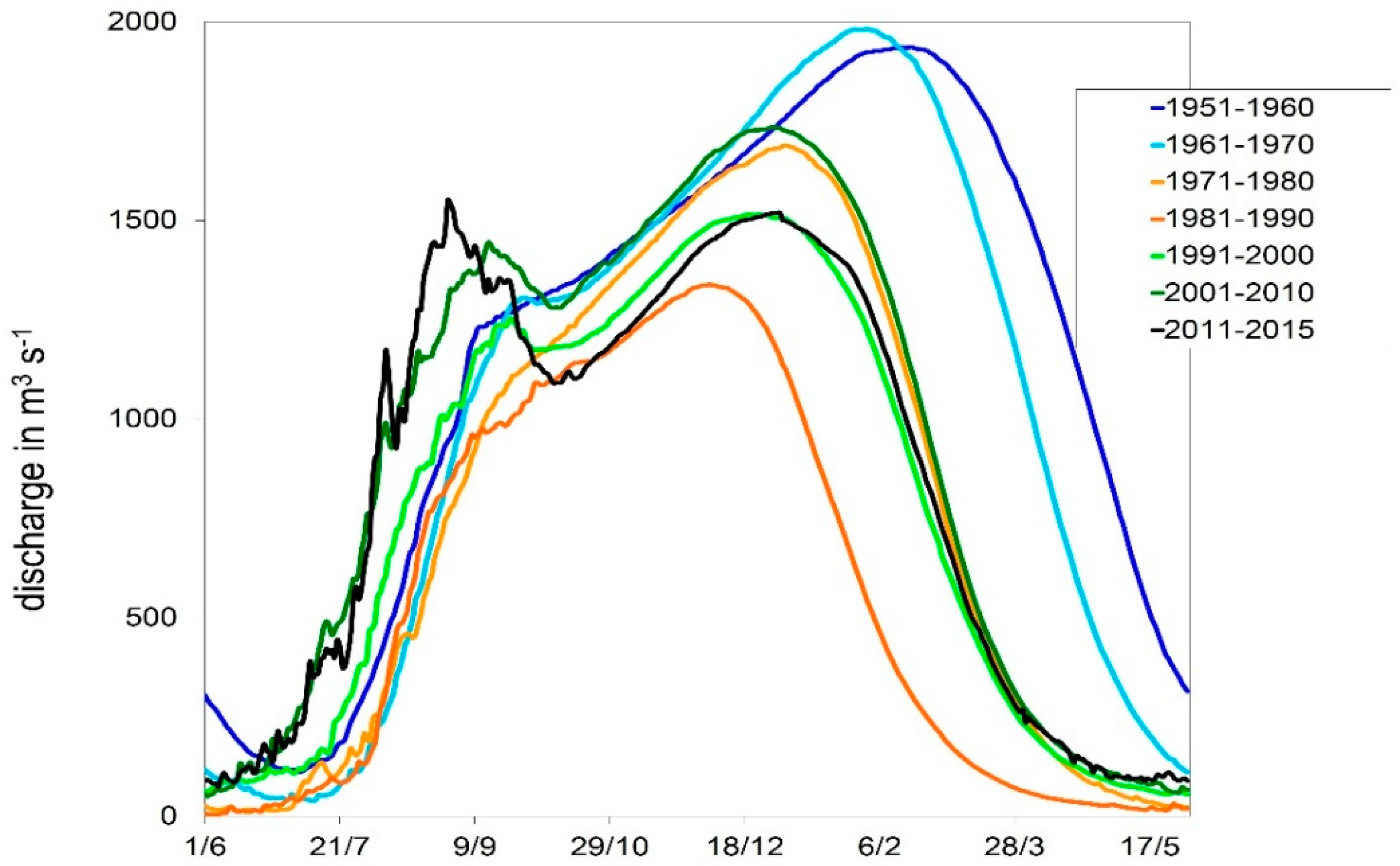
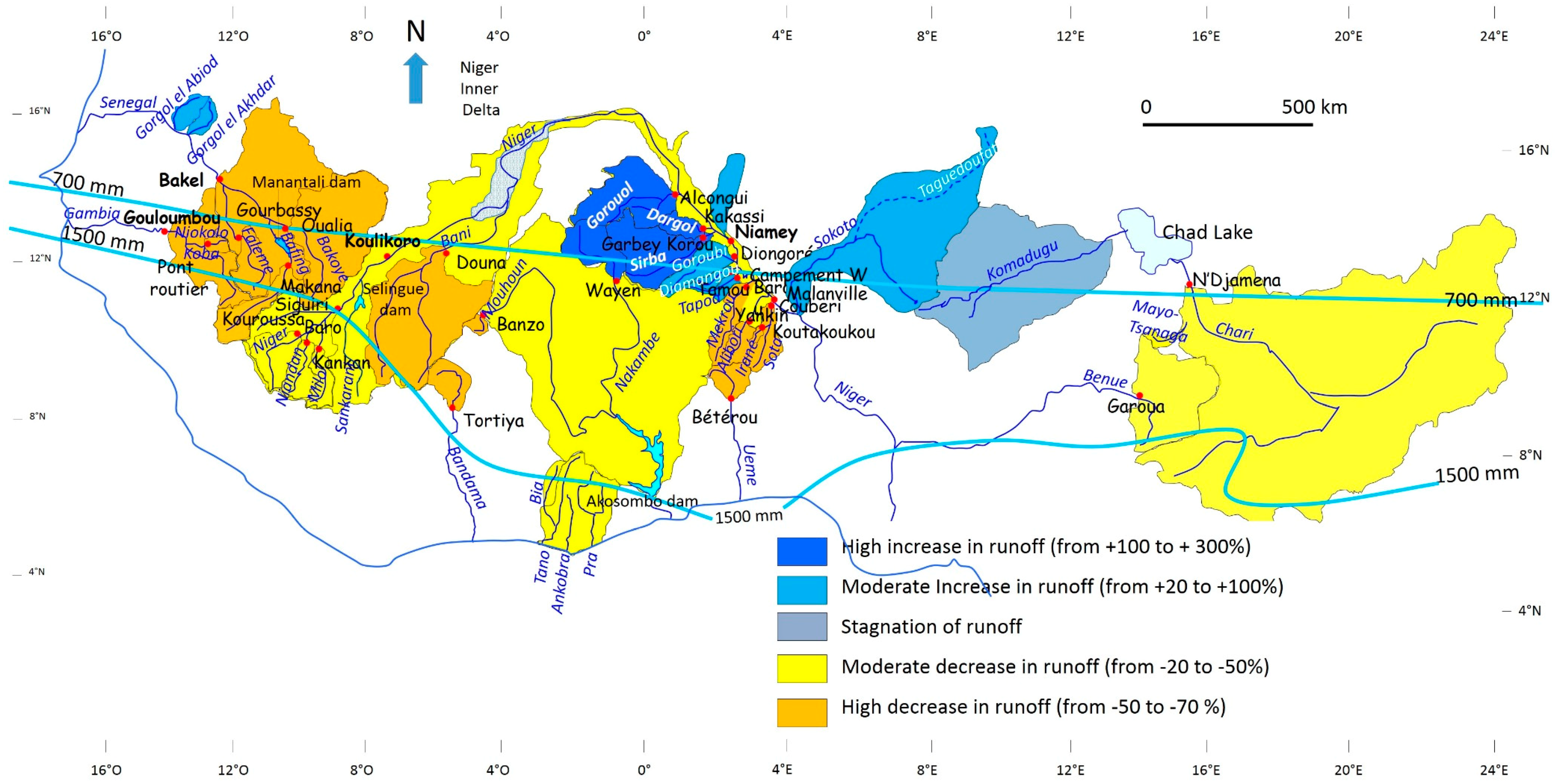
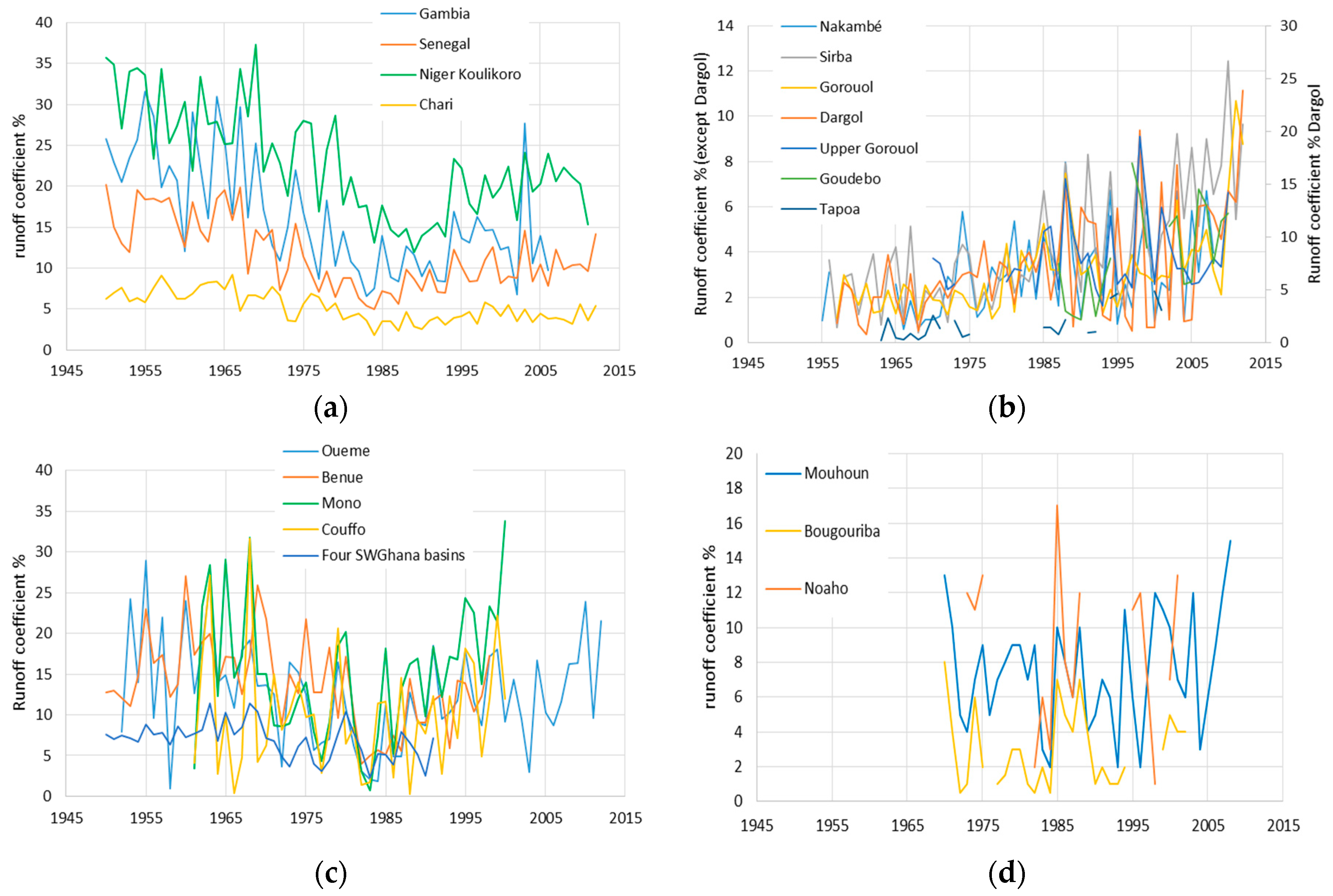
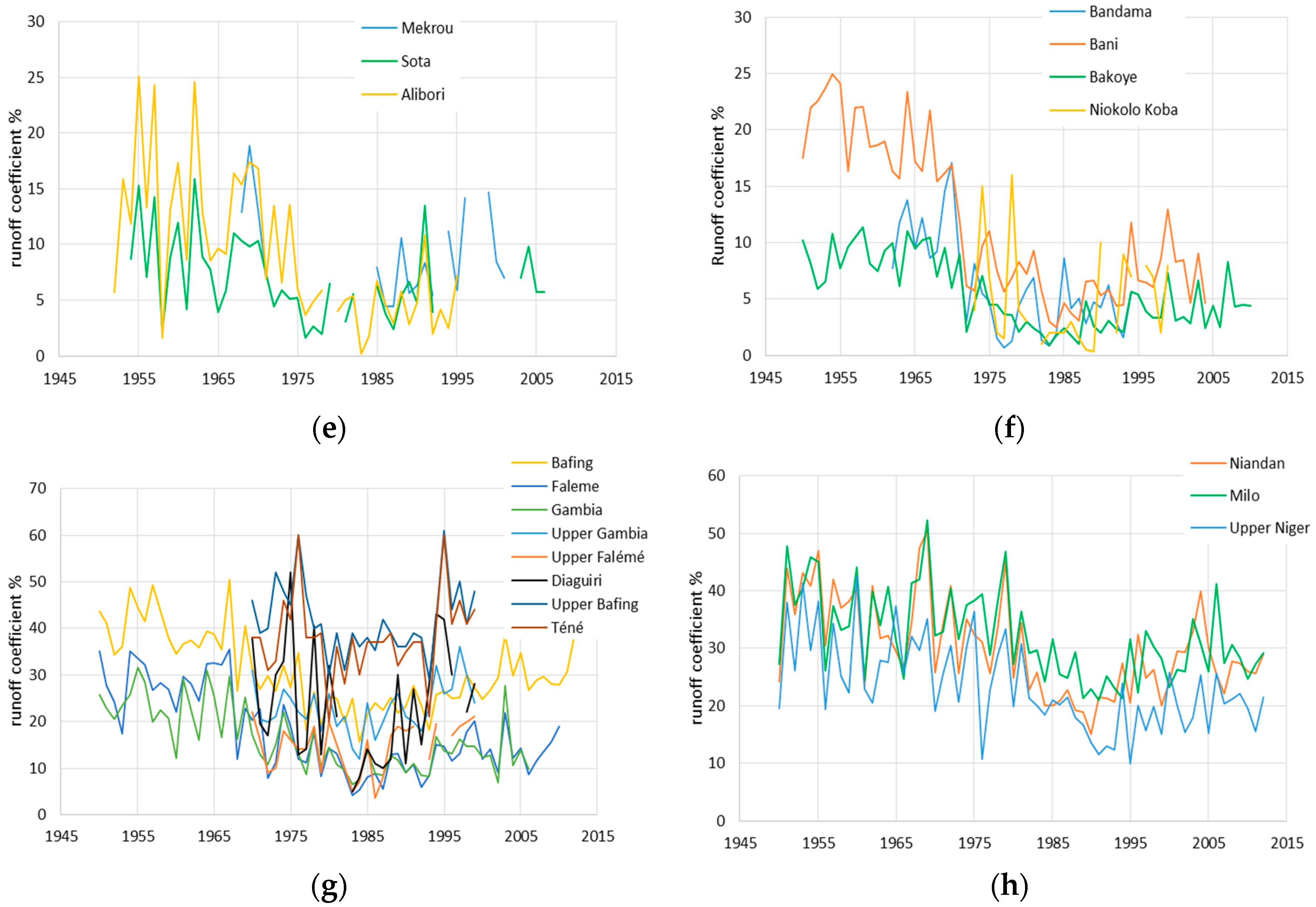
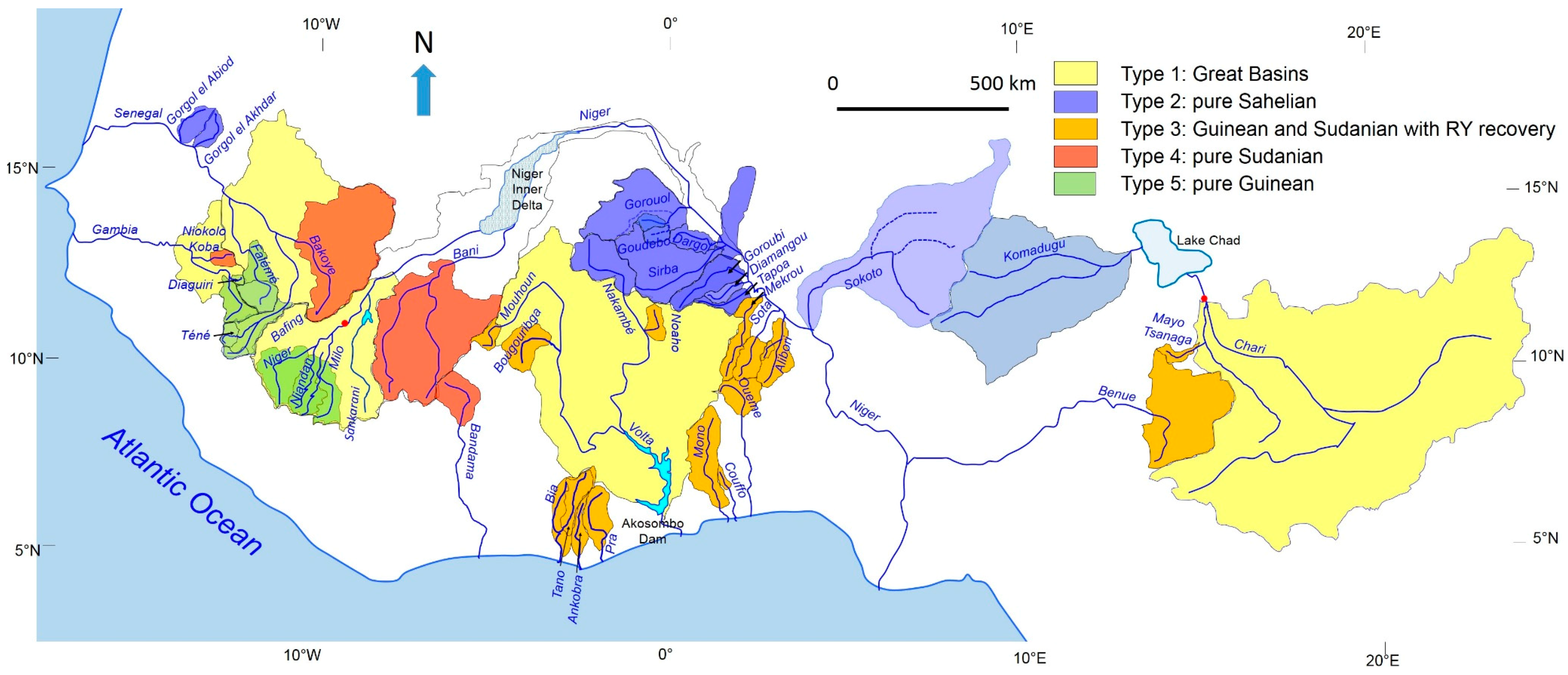
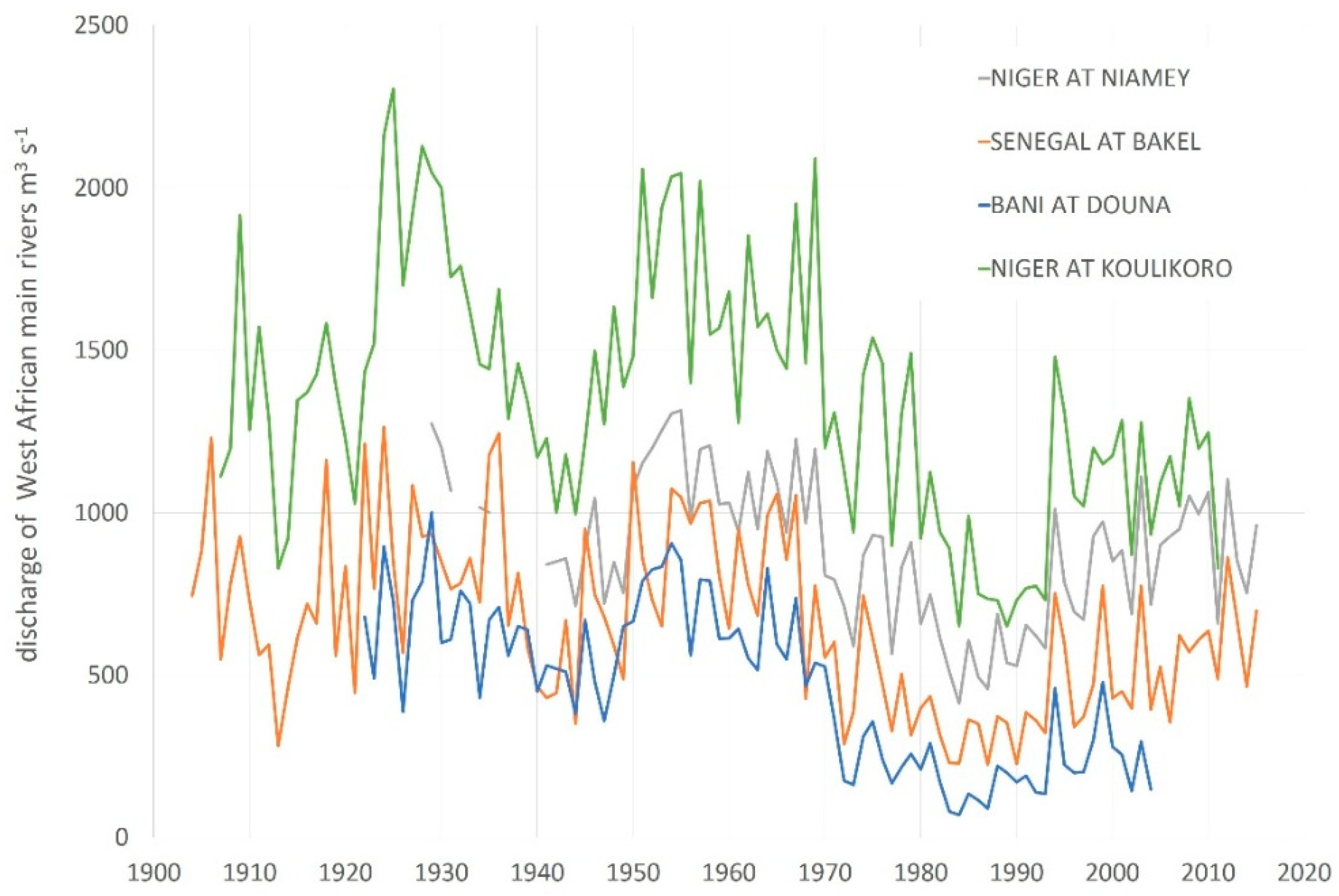

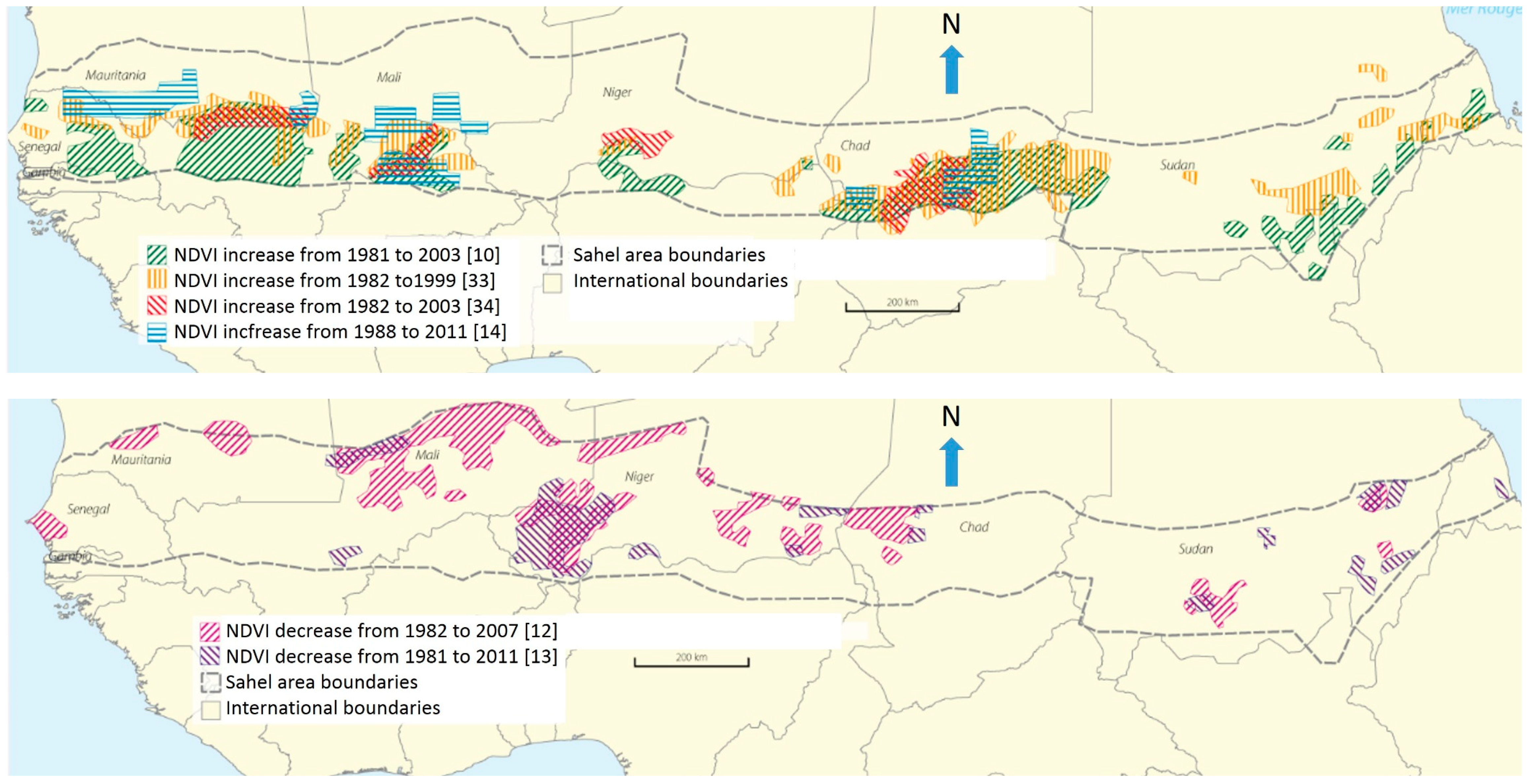
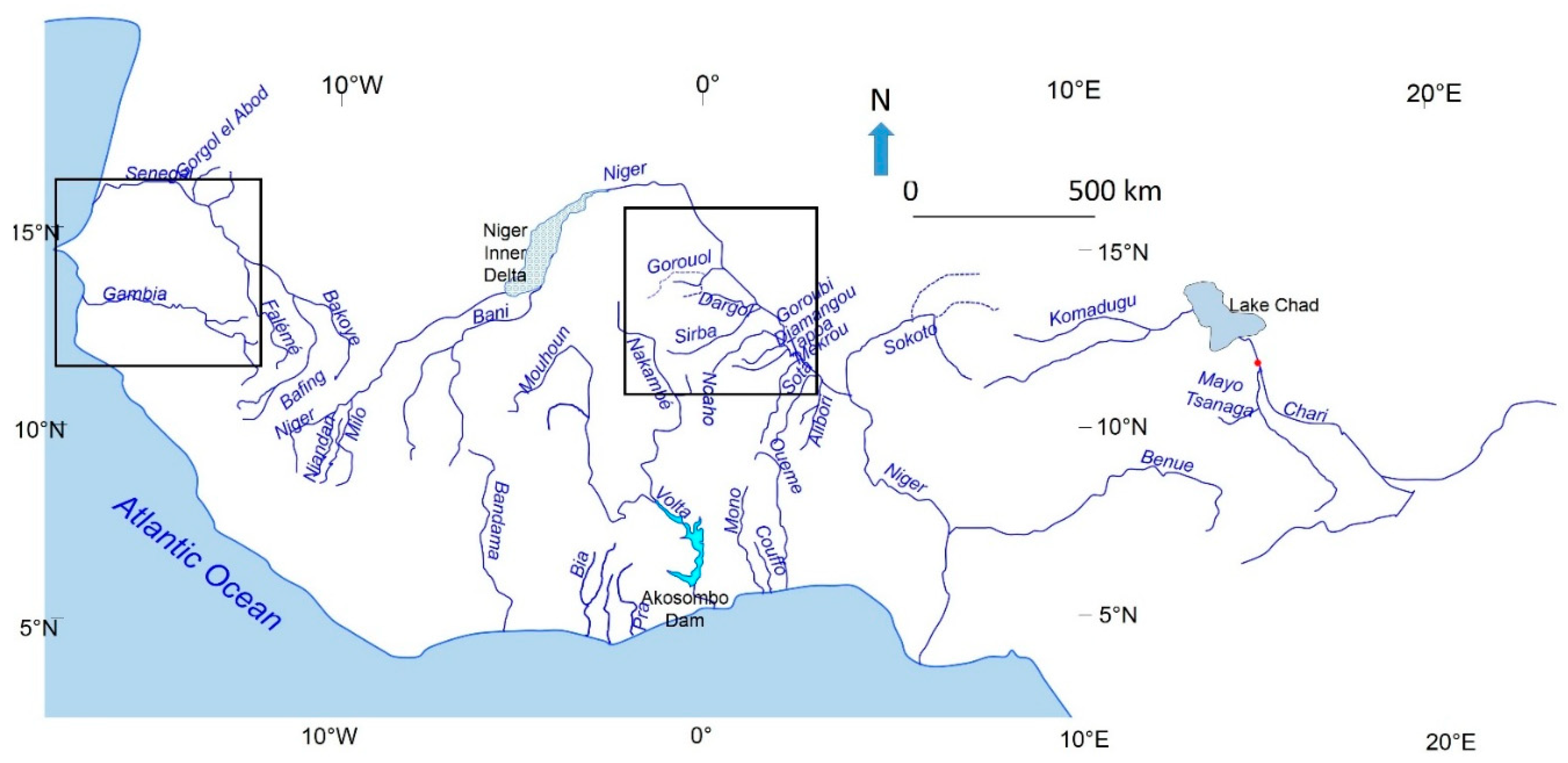
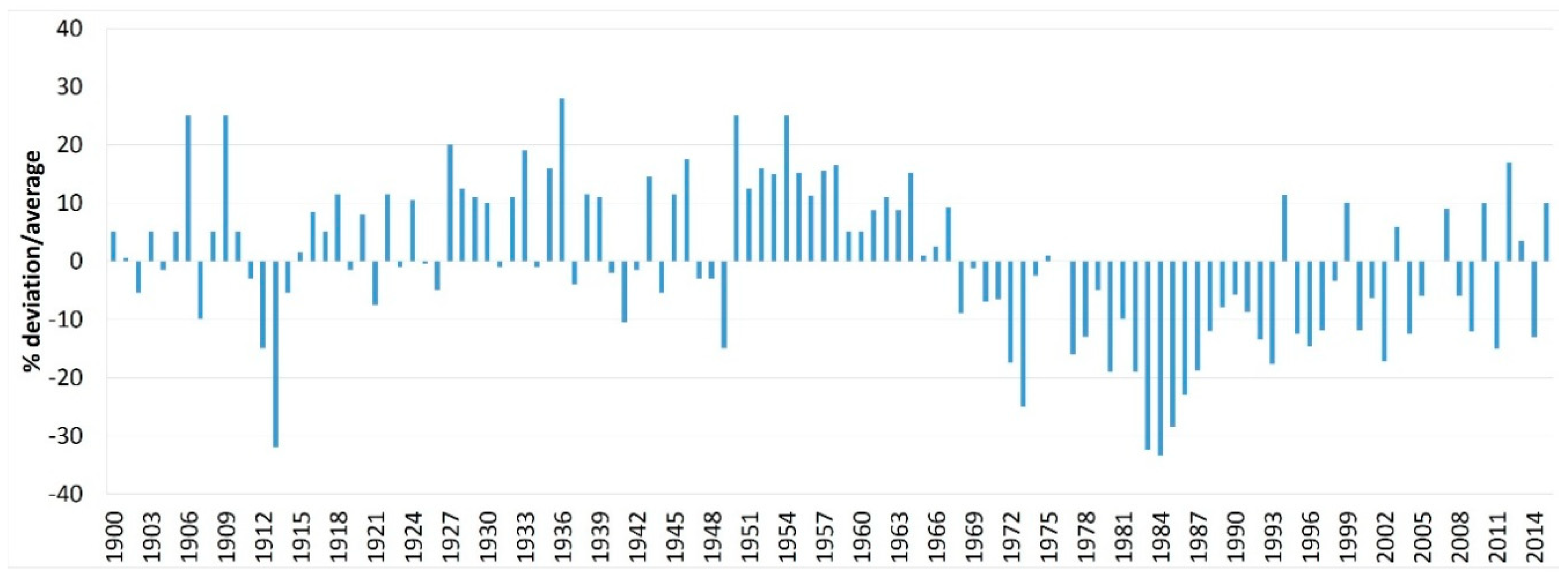
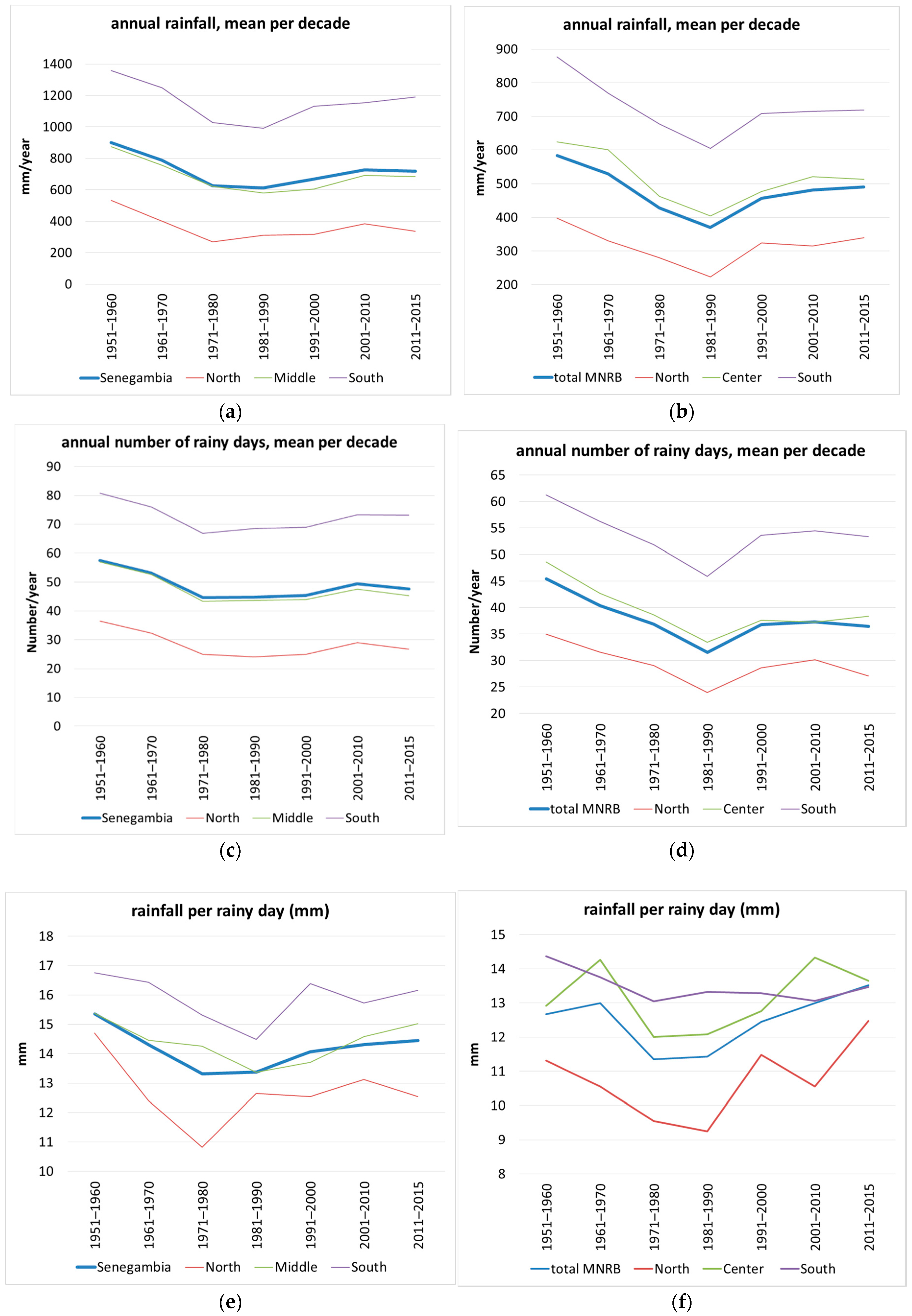
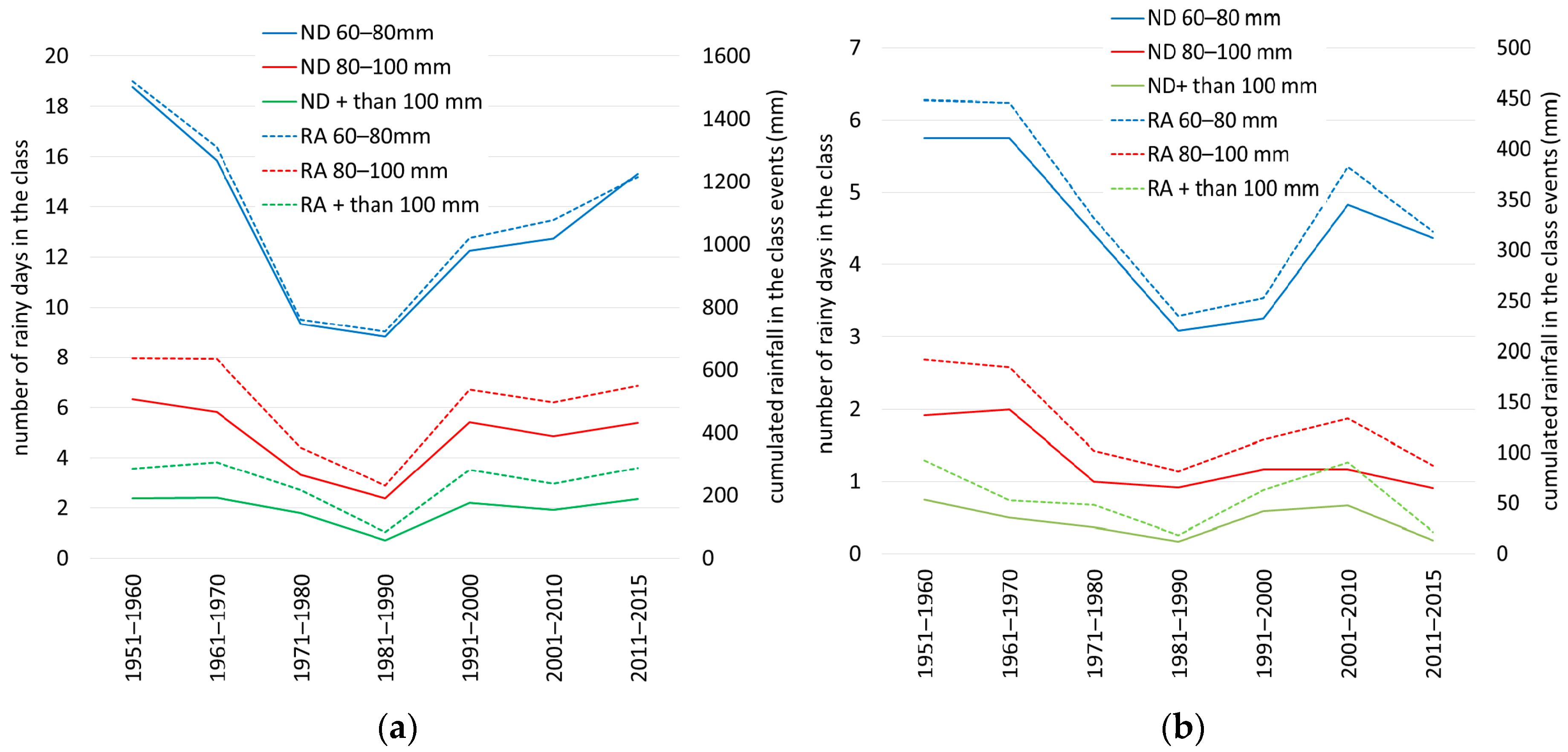
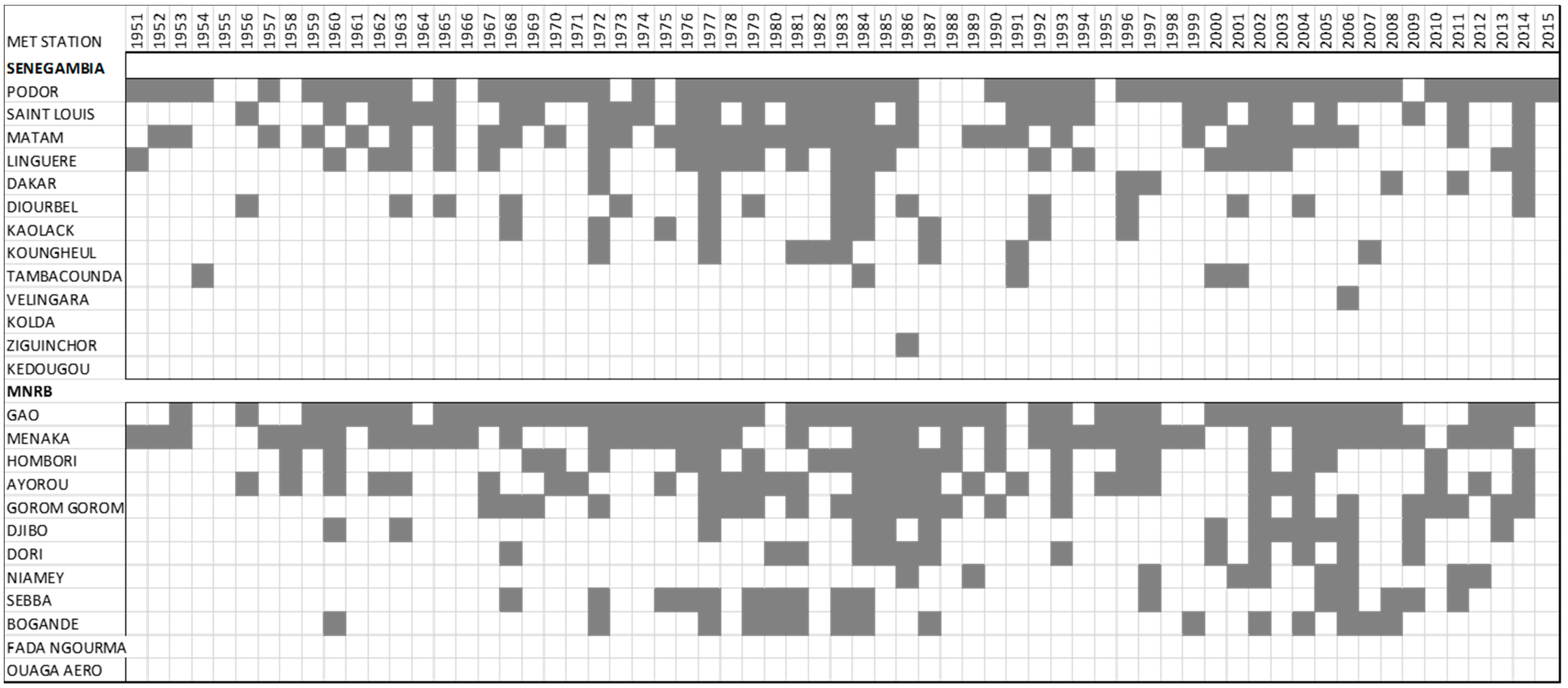
| Country | Time Span of Data | Source | ||
| Benin, Burkina Faso, Mali, Mauritania, Niger, Togo, Senegal | 1950–2012 | National Met Offices | ||
| Chad, Ghana, Guinea, Nigeria, Cameroon | 1950–1979 | SIEREM [23], Nat Met of | ||
| Chad, Ghana, Guinea, Nigeria | 1981–2010 | CHIRPS [24] | ||
| Basin | Time Span of Data | Missing | Reconstituted | Source |
| Alibori, Bani, Benue, Dargol, Diamangou, Goroubi, Gorouol, Mekrou, Niger-Koulikoro, Niger-Niamey, Sota, Tapoa | 1950–2012 | Numerous gaps | No reconstitution | NBA Niger Basin Authority |
| Milo, Upper Niger, Niandan | 1950–2012 | 4 years | 10 months | Nat Hydrol. Service Guinea |
| Ouémé | 1952–2012 | / | / | Nat Hydrol. Service Benin |
| Bafing, Bakoye, Faleme, Senegal | 1950–2012 | / | / | OMVS (Senegal Basin Authority) |
| Gambia, Koulountou | 1950–2005 | / | / | OMVG (Gambia basin authority) |
| Chari, Logone, Mayo Tsanaga | 1950–2012 | / | / | CBLT (Chad Lake basin Author) |
| Nakanbé, Volta | 1965–2008 | 3 years | No reconstitution | VBA (Volta Basin Authority) |
| Ankobra, Bra, Pia, Tano | 1951–1991 | / | / | Opoku et al. [25] |
| Gorgol el Abiod, Gorgol al Akhdar, Sokoto | 1958–1985 | 5 years | / | Mahé et al. [9,26] |
| Komadugu Yobe | 1950–2005 | Numerous gaps | No reconstitution | Genthon (personal communication) |
| Mono, Couffo | 1961–2000 | / | / | Amoussou et al. [27] |
| Bougouribga, Diaguiri, Goudebo, Niokolo Koba, Mouhoun, Noaho, Tene, Upper Faleme, Upper Gambia, Upper Gorouol | 1970–2006 | Numerous gaps | No reconstitution | Nka et al. [3] |
| Upper Bandama | 1950–2000 | / | / | Soro et al. [28] |
| Number | Variable |
|---|---|
| 1 | basin area |
| 2 | Mean annual rainfall (MAR) 1950–2012 |
| 3 | % of rainfall decrease during drought period: MAR 1968–1993/MAR 1950–1967 |
| 4 | % of rainfall recovery after drought MAR 1994–2012/MAR 1968–1993 |
| 5 | Time elapsed between rainfall break (1967 for all the basins) and discharge break (varying from 1967 to 1981 depending on the basin) |
| 6 | Mean annual discharge (1950–2012) |
| 7 | % discharge evolution during the drought (1968–1993)/the previous period (1950–1967) |
| 8 | % discharge evolution after the discharge break/before the break (year variable) |
| 9 | Time elapsed between the rainfall break (1967) and the RC (runoff coefficient) break |
| 10 | Mean annual RC before break (1950–1967) |
| 11 | % RC evolution during drought (RC 1968–1993/RC 1950–1967) |
| 12 | % RC evolution after drought (RC 1994–2012/RC 1968–1993) |
| Soil Surface Feature | Runoff Coefficient (%) | Saturated Hydraulic Conductivity (mm·h−1) |
|---|---|---|
| Millet on common sandy soil just after weeding | 4.0 ± 1.4 | 172 ± 79 (20) * |
| Fallow on common sandy soil | 10 ± 4 | 79 ± 41 (20) |
| Old fallow with bioderm | 25 ± 7 | 18 ± 12 (30) |
| Millet and fallow erosion (ERO) crusted soils | 60 ± 8 | 10 ± 5 (30) |
© 2018 by the authors. Licensee MDPI, Basel, Switzerland. This article is an open access article distributed under the terms and conditions of the Creative Commons Attribution (CC BY) license (http://creativecommons.org/licenses/by/4.0/).
Share and Cite
Descroix, L.; Guichard, F.; Grippa, M.; Lambert, L.A.; Panthou, G.; Mahé, G.; Gal, L.; Dardel, C.; Quantin, G.; Kergoat, L.; et al. Evolution of Surface Hydrology in the Sahelo-Sudanian Strip: An Updated Review. Water 2018, 10, 748. https://doi.org/10.3390/w10060748
Descroix L, Guichard F, Grippa M, Lambert LA, Panthou G, Mahé G, Gal L, Dardel C, Quantin G, Kergoat L, et al. Evolution of Surface Hydrology in the Sahelo-Sudanian Strip: An Updated Review. Water. 2018; 10(6):748. https://doi.org/10.3390/w10060748
Chicago/Turabian StyleDescroix, Luc, Françoise Guichard, Manuela Grippa, Laurent A. Lambert, Gérémy Panthou, Gil Mahé, Laetitia Gal, Cécile Dardel, Guillaume Quantin, Laurent Kergoat, and et al. 2018. "Evolution of Surface Hydrology in the Sahelo-Sudanian Strip: An Updated Review" Water 10, no. 6: 748. https://doi.org/10.3390/w10060748
APA StyleDescroix, L., Guichard, F., Grippa, M., Lambert, L. A., Panthou, G., Mahé, G., Gal, L., Dardel, C., Quantin, G., Kergoat, L., Bouaïta, Y., Hiernaux, P., Vischel, T., Pellarin, T., Faty, B., Wilcox, C., Malam Abdou, M., Mamadou, I., Vandervaere, J.-P., ... Paturel, J.-E. (2018). Evolution of Surface Hydrology in the Sahelo-Sudanian Strip: An Updated Review. Water, 10(6), 748. https://doi.org/10.3390/w10060748






